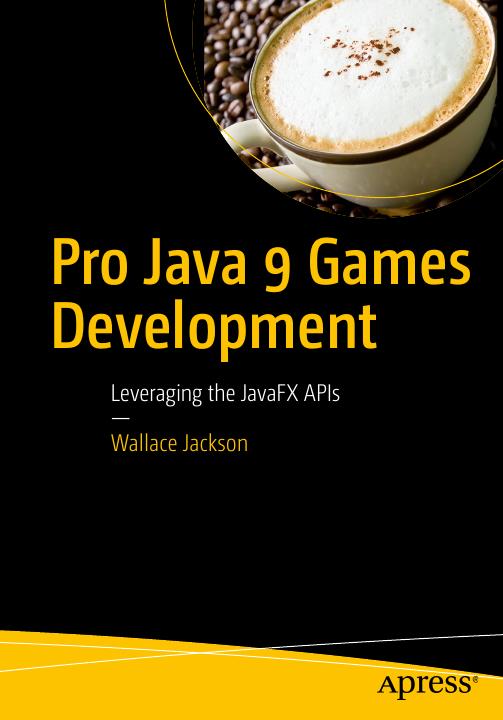Name of the book: Pro Java 9 Games Development
Year: 2017
Author: Wallace Jackson
Pages: 633
Lauguage: English
Format: pdf, fb2, epub
The size: 50 MB, 59 MB, 40 MB
Description of book “Pro Java 9 Games Development (2017)“:
The Java 9 Programming Language is currently the most popular object-oriented programming (OOP) language in the world today. Java runs on consumer electronic devices from SmartWatches to UHD Smartphones, to Touchscreen Tablets, to eBook Readers, to Game Consoles, to SmartGlasses, to Ultra-High Definition (UHD) 4K Interactive Television Sets (or iTV Sets), with even more types of consumer electronics devices, such as those found in the automotive, home appliances, healthcare, digital signage, security, home automation market, VR AR and so on, increasingly adopting this open source Java 9 platform for usage to drive i3D new media experiences within their hardware devices.
Since there are literally billions of Java 9 compatible consumer electronics devices, owned by the billions of users all over the world, it stands to reason that developing popular Pro Java 9 Games for all of these people could be an extremely lucrative undertaking, given that you have the right game concepts, artwork, new media assets, game design, and optimization processes, of course.
Java 9 (and its multimedia engine, JavaFX 9) code can run on just about every operating system out there, including Windows 7, 8.1 and 10, Linux distributions such as Ubuntu LTS 18 or Fedora, 32-bit Android 1-4 and 64-bit Android 5-8, Open Solaris, Macintosh OS/X, iOS, Symbian, and the Raspberry Pi, it’s only a matter of time before any other popular OSes will add support for this popular open source programming language. Additionally, every popular Internet Browser has Java capability. Java provides the ultimate flexibility in installing software, as an application, or in the browser, as an applet. You can even drag a Java application right out of the browser, and have it install itself on a user’s desktop. Java 9 is truly remarkable technology all the way around.
There are a plethora of embedded and desktop hardware support levels currently for Java 9 and for JavaFX 9, including the full Java SE 9, Java SE 9 Embedded, Java ME (Micro Edition) 9 and Java ME 9 Embedded, as well as Java EE 9 for Enterprise Application Development.
Table of Contents:
- Chapter 1: The Different Faces of Java: Create a Java 9 Development
Workstation - Chapter 2: An Introduction to Content Creation: 2D New Media Asset
Fundamentals - Chapter 3: Advanced 3D Content Rendering: 3D Asset Concepts and
Principles - Chapter 4: An Introduction to Game Design: Game Design Concepts,
Genres, Engines, and Techniques - Chapter 5: A Java Primer: Introduction to Java Concepts and Principles
- Chapter 6: Setting Up Your Java 9 IDE: An Introduction to NetBeans 9
- Chapter 7: Introduction to JavaFX 9: Overview of the JavaFX
New Media Engine - Chapter 8: JavaFX 9 Scene Graph Hierarchy: A Foundation for
Java 9 Game Design - Chapter 9: JavaFX 9 User Interface Design: The Front End for
Java 9 Game Design - Chapter 10: User Interface Design Interactivity: Event Handling and
Imaging Effects - Chapter 11: 3D Scene Configuration: Using the PerspectiveCamera
and PointLight - Chapter 12: 3D Model Design and Primitives: Using JavaFX 9
Shape3D Classes - Chapter 13: 3D Model Shader Creation: Using the JavaFX 9
PhongMaterial Class - Chapter 14: 3D Model Hierarchy Creation: Using Primitives to Create a
Game Board - Chapter 15: 3D Gameplay UI Creation: Using the Sphere Primitive to
Create a UI Node - Chapter 16: 3D Game Animation Creation: Using the Animation
Transition Classes - Chapter 17: i3D Game Square Selection: Using the PickResult Class with
3D Models - Chapter 18: 3D Gameplay Design: Creating Your Game Content Using
GIMP and Java - Chapter 19: Game Content Engine: AI Logic with Random Content
Selection Methods - Chapter 20: Coding Gameplay: Set Up Gameplay Methods and
Animated Camera View - Chapter 21: Questions and Answers: Finishing the Setup Methods
and Digital Audio - Chapter 22: Scoring Engine: Creating the Score UI Layout and Scoring
the Content - Chapter 23: Completing the Gameplay Code and Player Proofing
Your Event Handling - Chapter 24: Optimizing Game Assets and Code, and Game Profiling Using
NetBeans
Download the book “Pro Java 9 Games Development (2017)”:



